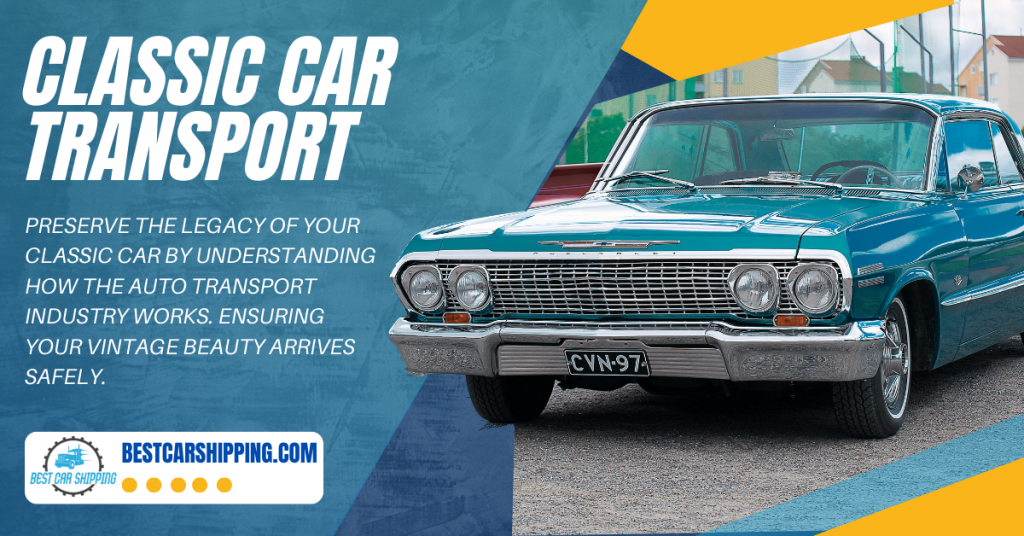For automotive enthusiasts, few possessions evoke such profound emotions as a classic car. These rolling works of art, adorned with gleaming chrome and steeped in history, transcend mere transportation. They’re cherished windows into bygone eras, whispering tales of innovation, elegance, and the unbridled spirit of the open road. But when it comes to relocating these irreplaceable treasures, entrusting them to just any transport service won’t do. This comprehensive guide dives deep into the intricacies of classic car transport, empowering you with the knowledge and insights to make informed decisions for your beloved vintage automobile.
The Delicate Dance of Trust and Expertise
Choosing the right classic car transport service isn’t simply about ticking boxes on a checklist. It’s a delicate dance of trust, where you hand over a piece of your automotive heart to a company entrusted with its safe passage. Unlike ordinary cars, classic vehicles demand meticulous care, specialized handling, and unwavering reliability. A misstep by the transporter can not only inflict damage to a prized possession, but also leave emotional scars on the owner.
Unpacking the Pillars of Excellence
Three pillars underpin the ideal classic car transport service: reliability, security, and expertise. Let’s delve into each, equipping you with the knowledge to discern the finest carriers for your vintage gem.
1. Reliability
A reliable transporter is the bedrock of your peace of mind. Look for a company with an impeccable track record in classic car shipping, one that emphasizes:
- Timely Deliveries: Your car arrives when estimated, no agonizing delays or missed deadlines.
- Transparent Communication: You’re kept informed at every step of the journey, from pickup to delivery.
- Exceptional Customer Service: Your concerns are promptly addressed, and questions answered with courtesy and knowledge.
Delve deeper into the company’s history. Are they licensed and insured? Do they have an exceptional track record when it comes to customer reviews? Be sure to look into the companies you’re interested in, as this will provide you with an added layer of trust and accountability.
2. Security
Your classic car deserves fortress-like protection. Prioritize enclosed trailers equipped with:
- Climate Control: Protect your pride and joy from the harsh elements, preserving its pristine condition.
- Secure Tie-Down Points: These points strategically anchor the car, preventing movement and potential damage during transit.
- Shock-Absorbing Suspension: Every bump and jostle is minimized, ensuring your classic car arrives unscathed.
Don’t hesitate to inquire about the company’s safety protocols. How thoroughly are drivers trained in handling vintage vehicles? What procedures are in place in case of unforeseen incidents? Knowing these measures in place provides invaluable peace of mind.
3. Expertise
Experience makes all the difference. Choose a transporter that is well versed in the transportation of classic cars, not one-size-fits-all companies. Their team should possess:
- Deep Understanding of Classic Cars: They know the specific needs and vulnerabilities of vintage vehicles, from delicate paintwork to finicky fuel systems.
- Gentle Handling Techniques: No harsh jabs or brute force. They treat your car with the utmost care, using specialized equipment and soft straps to minimize stress.
- Communication is Paramount: Maintain open communication with the transporter throughout the process. Ask questions, express concerns, and stay informed about your car’s progress. A responsive and communicative transporter fosters trust and alleviates anxieties.
Best Practices for a Seamless Relocation
Beyond choosing the right transporter, meticulous preparation on your end ensures a smooth and worry-free journey. Here are some best practices:
- Pre-Transport Preparations:
- Photo Documentation: Take detailed photos of your car, highlighting any existing scuffs or dents. This serves as valuable documentation in case of unforeseen damage.
- Fuel Level: A quarter tank of gas is best.
- Battery: Ensuring that your car’s battery is charged will help you to avoid delays or potential increased fees due to an unexpectedly inoperable vehicle.
- Personal Belongings: Remove any valuables from the car to avoid potential loss or damage.
- Bill of Lading: Obtain a detailed bill of lading at both pick up and delivery. This document will show any damages to the vehicle at the time of pickup, and will show any new damages at the time of delivery. Be sure to review the Bill of Lading thoroughly before signing it.
Packaging and Secure Loading
Beyond removing personal belongings, ensuring your classic car arrives pristine requires proper packaging and loading techniques. Here’s what to look for in a transporter:
- Breathable Car Covers: A breathable car cover protects your vehicle from dust, dirt, and minor scratches during the journey. Opt for natural fabrics like cotton or canvas over synthetic materials that can trap moisture and lead to mildew.
- Strategic Padding: Vulnerable areas like bumpers, fenders, and hood ornaments deserve extra protection. Look for a transporter that uses soft padding and corner guards to absorb bumps and prevent denting.
- Expertise in Secure Loading: Witnessing the loading process is crucial. Observe how your car is positioned within the trailer, ensuring proper weight distribution and secure tie-down points. Don’t hesitate to ask questions and voice concerns regarding the chosen tie-down techniques and padding placement.
Remember, a reputable transporter will be transparent about their loading procedures and welcome your involvement in the process. By entrusting your classic car to professionals who employ meticulous packaging and secure loading techniques, you can be confident it will arrive at its destination looking its best, ready to turn heads and capture hearts for generations to come.
Unpacking the Options
The ideal transport method hinges on your specific needs and budget. Here’s a breakdown of the most common options:
- Enclosed Trailers: The gold standard for classic car transport, offering unparalleled protection from the elements, road debris, and prying eyes. Ideal for long distances, valuable cars, and those with delicate finishes.
- Open Trailers: A more affordable option for shorter distances and less vulnerable cars. While weather and road hazards pose a greater risk, reputable transporters employ weatherproof covers and secure tie-down techniques to mitigate these concerns.
- Flatbed Trailers: Perfect for inoperable or low-clearance vehicles, providing a level and secure platform for the journey.
Beyond the Road: Additional Considerations
Remember, the journey doesn’t end at the destination. Factor in these additional considerations for a truly seamless experience:
- Offloading and Inspection: Be present for the car’s offloading and thoroughly inspect it for any potential damage incurred during transport. Document any issues immediately on the bill of lading, and communicate the damages to your auto shipping company.
- Post-Transport Care: Depending on the distance and duration of the journey, your classic car may require some post-transport TLC. Wash it gently to ensure that no scratches were missed, and start the engine to ensure everything is functioning properly.
Frequently Asked Questions – Classic Car Transport
Q: Is door to door service available for classic auto shipping?
A: Absolutely! Most auto transport brokers work with a wide network of carriers equipped to handle the gentle touch necessary when transporting a classic car. They’ll be sure to ensure a convenient and tailored experience for all your auto shipping needs, including door to door service if requested.
Q: My classic car doesn’t run. Can it still be transported?
A: Most transporters offer options for non-running vehicles, including flatbed trailers and ramps designed for safe loading and unloading. Inform the car shipping company of your vehicle’s condition beforehand so they can arrange the appropriate equipment and handling techniques. Keep in mind, inoperable vehicle transport will likely be more expensive than shipping a classic car in running condition.
Q: Can I choose a specific time or date for the pickup and delivery of my classic car?
A: While all efforts will be made to deliver vehicles within a customer’s requested timeframe, guaranteed dates are tricky when it comes to auto transport. Pick up and delivery times are subject to influences like distance, traffic, and seasonal factors. Your car shipping company will provide you with estimated dates, but be weary of any companies guaranteeing dates, only to end up overpromising and underdelivering.
Q: What additional considerations are there for long-distance classic car transport?
A: For cross-country journeys, inquire about climate-controlled trailers to protect your car from extreme temperatures and humidity. Discuss maintenance checks during long hauls and consider opting for dedicated drivers who specialize in long-distance classic car transport.
Q: My classic car has unique modifications or custom parts. Do I need to inform the auto shipping company?
A: Definitely disclose any modifications or non-standard components to the transporter upfront. This will allow them to assess potential loading challenges and ensure they have the necessary equipment to handle your car safely. Photographs and detailed descriptions of modifications are always helpful for clear communication.
Q: I’m considering transporting my classic car to a car show or event. Does the transporter offer any special services?
A: Some transporters specialize in event transportation and offer services like pre-show detailing, staging assistance, and secure on-site storage. Discuss your event needs with the transporter to see if they can tailor their services to your specific requirements, ensuring your classic car arrives looking its absolute best and ready to steal the show.
Transporting your classic car shouldn’t be a nerve-wracking experience. By prioritizing reliability, security, and expertise, preparing your car, and choosing the right transport method, you can ensure your automotive gem arrives at its destination safe and sound. Remember, your classic car deserves a journey befitting its timeless legacy, one marked by care, precision, and the utmost respect for its historical significance. With the knowledge and insights gleaned from this guide, you can confidently hand over the reins of your automotive dream, letting it embark on a new chapter in its storied journey.

